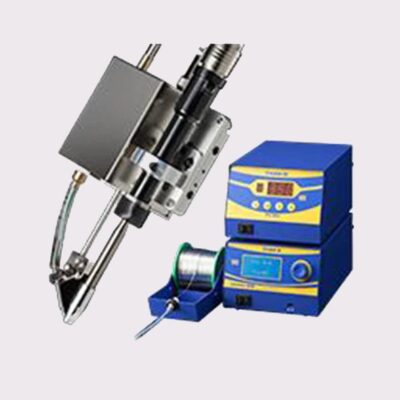In the realm of electronics manufacturing, precision and efficiency are paramount. Automatic soldering has emerged as a pivotal technology, particularly in Printed Circuit Board Assembly (PCBA), where consistent quality and speed are essential. Sumitron, a leading distributor of advanced soldering equipment in India, offers a range of solutions that cater to these needs, helping businesses streamline production and reduce defects.
Understanding Automatic Soldering in PCBA
Automatic soldering refers to the use of robotic systems and machines to perform soldering tasks on PCBs. This automation ensures uniformity, reduces human error, and increases throughput. In PCBA, where components are densely packed and miniaturized, manual soldering becomes challenging and time-consuming. Automated systems address these challenges by providing precise control over soldering parameters, such as temperature, solder feed rate, and dwell time, ensuring every joint meets quality standards.
Moreover, the growing complexity of modern electronics, with components like fine-pitch ICs, micro-BGAs, and multilayer PCBs, makes manual soldering impractical. Automatic soldering machines handle these intricate assemblies with consistency, delivering reliable results even in high-volume production.
Key Automatic Soldering Solutions Offered by Sumitron
1. Tsutsumi Soldering Robots
Sumitron’s collaboration with Tsutsumi brings forth a series of soldering robots designed for high-precision tasks. Models like the Tsutsumi iCross TX-i 224 offer a 4-axis simultaneous control system, enabling both point and slide soldering. With a compact design and high rigidity, these robots ensure accurate repetitions, making them ideal for intricate soldering applications.
The Tsutsumi robots are equipped with advanced programming capabilities, allowing manufacturers to create custom soldering paths and automate complex operations. This flexibility reduces setup time and adapts easily to different product designs, providing a scalable solution for growing production demands.
2. Selective Soldering Machines
For components sensitive to heat, selective soldering machines provide targeted soldering capabilities. These machines apply solder only to specific areas, preventing damage to surrounding components. Sumitron’s offerings in this category cater to various PCBA requirements, ensuring quality without compromising component integrity.
Selective soldering machines are particularly useful in mixed-technology assemblies, where through-hole components coexist with SMT components. The precision of selective soldering minimizes thermal stress, which can otherwise affect sensitive components and reduce overall product reliability.
3. Wave & Reflow Soldering Machines
Wave soldering is effective for large-scale PCB assemblies, especially those with a mix of leaded and surface-mount components. Reflow soldering, on the other hand, is widely used for surface-mount technology (SMT) components. Sumitron’s machines in this category, such as the DATAPAQ Reflow Tracker System, offer automated soldering processes that ensure consistent quality and reduce power consumption.
Wave Automatic soldering machines create a continuous flow of molten solder that efficiently joins multiple PCB connections simultaneously, increasing production speed. Reflow soldering, with precise temperature profiling, ensures solder melts and solidifies without defects like tombstoning or solder bridging, guaranteeing strong and reliable connections.
Advantages of Adopting Automatic Soldering
-
Consistency: Automated systems provide uniform soldering, reducing variability and defects. Each solder joint is produced with the same high quality, eliminating human inconsistencies.
-
Speed: Robotic systems can operate continuously, increasing production rates and meeting high-volume manufacturing targets.
-
Precision: Advanced controllers and sensors ensure accurate application of solder, crucial for miniaturized PCBs and fine-pitch components.
-
Cost-Effectiveness: While the initial investment may be significant, the reduction in defects, rework, and production downtime leads to long-term savings.
-
Enhanced Safety: Automation minimizes direct human exposure to hot soldering irons, fumes, and flux chemicals, improving workplace safety.
-
Scalability: Automated soldering systems can easily accommodate changes in production volume, new product designs, and complex PCBA requirements.
Integrating Automatic Soldering into Your Workflow
Implementing automatic soldering requires careful planning. It’s essential to assess the specific needs of your PCBA process, considering factors like component types, board sizes, production volumes, and complexity. Sumitron’s team can assist in selecting the right equipment and providing training to ensure seamless integration into existing workflows.
Successful integration involves workflow analysis, soldering path optimization, and regular maintenance of machines. Incorporating inline quality inspection systems, such as automated optical inspection (AOI), further enhances production reliability by detecting defects early in the process.
Use Cases and Applications
Automatic soldering finds application across various industries:
-
Consumer Electronics: High-volume production of smartphones, tablets, and laptops demands precision soldering.
-
Automotive Electronics: Soldering ECUs, sensors, and connectors requires consistent reliability under thermal and vibration stress.
-
Medical Devices: Critical medical PCBs, like pacemakers and diagnostic equipment, need defect-free solder joints to ensure patient safety.
-
Industrial Electronics: Automation systems, PLCs, and controllers rely on precise soldering for long-term durability and performance.
Conclusion
Automatic soldering stands at the forefront of modern electronics manufacturing. With Sumitron’s diverse range of solutions, manufacturers can achieve enhanced precision, efficiency, and quality in their PCBA processes. Embracing these technologies not only meets current industry standards but also positions businesses for future growth in an increasingly competitive market. Whether for small-scale specialized production or high-volume industrial manufacturing, automatic soldering ensures that every PCB meets rigorous quality requirements, boosting overall productivity and reliability.
Read Also This Blog
